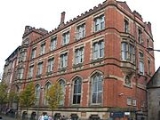
Manchester Castle
Encyclopedia
Manchester Castle was a medieval fortified manor house
, probably located on a bluff
where the rivers Irk
and Irwell
meet, near to Manchester Cathedral
, underneath where Chetham's School of Music
now is, putting it near the edge of the medieval township of Manchester
.
constructed from timber and with a wooden palisade
. This earlier castle has been described as "of no political or military importance". Three rings of ditches have been discovered surrounding the likely site of the castle, however these may be part of a Saxon burh
or Norman castle.
In his book Warfare in England (1912), author and historian Hilaire Belloc
identified the "Manchester Gap", between the Pennines and the Mersey estuary, to be one of the two most important defensive lines in medieval England along with the line of the River Thames
. Although Belloc ascribed great important to Manchester and its possible ability to hamper troop movements, castle historian D. J. Cathcart King refuted Belloc as the site was forgotten at an early date.
Manor house
A manor house is a country house that historically formed the administrative centre of a manor, the lowest unit of territorial organisation in the feudal system in Europe. The term is applied to country houses that belonged to the gentry and other grand stately homes...
, probably located on a bluff
Hill
A hill is a landform that extends above the surrounding terrain. Hills often have a distinct summit, although in areas with scarp/dip topography a hill may refer to a particular section of flat terrain without a massive summit A hill is a landform that extends above the surrounding terrain. Hills...
where the rivers Irk
River Irk
The River Irk is a river in Greater Manchester in North West England that flows through the northern suburbs of Manchester before merging with the River Irwell in Manchester city centre....
and Irwell
River Irwell
The River Irwell is a long river which flows through the Irwell Valley in the counties of Lancashire and Greater Manchester in North West England. The river's source is at Irwell Springs on Deerplay Moor, approximately north of Bacup, in the parish of Cliviger, Lancashire...
meet, near to Manchester Cathedral
Manchester Cathedral
Manchester Cathedral is a medieval church on Victoria Street in central Manchester and is the seat of the Bishop of Manchester. The cathedral's official name is The Cathedral and Collegiate Church of St Mary, St Denys and St George in Manchester...
, underneath where Chetham's School of Music
Chetham's School of Music
Chetham's School of Music , familiarly known as "Chets", is a specialist independent co-educational music school, situated in Manchester city centre, in North West England. It was established in 1969, incorporating Chetham's Hospital School, founded as a charity school by Humphrey Chetham in 1653...
now is, putting it near the edge of the medieval township of Manchester
Manchester Township (England)
Manchester Township was one of the many townships and chapelries which formed the ancient parish of Manchester within the Salford hundred of Lancashire, England. It included the area of what is now Manchester City Centre and the adjoining area of Ancoats....
.
History
Manchester Castle was first referred to in 1184; in 1215 it was recorded as belonging to the Greley family, who were barons of Manchester. This is the last historic reference to the castle. Before the manor house was built, Manchester Castle may have taken the form of a ringworkRingwork
A ringwork is a form of fortified defensive structure, usually circular or oval in shape. Ringworks are essentially motte-and-bailey castles minus the motte...
constructed from timber and with a wooden palisade
Palisade
A palisade is a steel or wooden fence or wall of variable height, usually used as a defensive structure.- Typical construction :Typical construction consisted of small or mid sized tree trunks aligned vertically, with no spacing in between. The trunks were sharpened or pointed at the top, and were...
. This earlier castle has been described as "of no political or military importance". Three rings of ditches have been discovered surrounding the likely site of the castle, however these may be part of a Saxon burh
Burh
A Burh is an Old English name for a fortified town or other defended site, sometimes centred upon a hill fort though always intended as a place of permanent settlement, its origin was in military defence; "it represented only a stage, though a vitally important one, in the evolution of the...
or Norman castle.
In his book Warfare in England (1912), author and historian Hilaire Belloc
Hilaire Belloc
Joseph Hilaire Pierre René Belloc was an Anglo-French writer and historian who became a naturalised British subject in 1902. He was one of the most prolific writers in England during the early twentieth century. He was known as a writer, orator, poet, satirist, man of letters and political activist...
identified the "Manchester Gap", between the Pennines and the Mersey estuary, to be one of the two most important defensive lines in medieval England along with the line of the River Thames
River Thames
The River Thames flows through southern England. It is the longest river entirely in England and the second longest in the United Kingdom. While it is best known because its lower reaches flow through central London, the river flows alongside several other towns and cities, including Oxford,...
. Although Belloc ascribed great important to Manchester and its possible ability to hamper troop movements, castle historian D. J. Cathcart King refuted Belloc as the site was forgotten at an early date.

